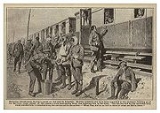
Hospital train
Encyclopedia

Train
A train is a connected series of vehicles for rail transport that move along a track to transport cargo or passengers from one place to another place. The track usually consists of two rails, but might also be a monorail or maglev guideway.Propulsion for the train is provided by a separate...
with carriages equipped for the provision of healthcare. Historically this has ranged from trains equipped to transport wounded soldiers, with basic nursing and first aid facilities on board, to fully equipped mobile medical centres, sometimes including operating theatres and nursing wards.

Hospital trains in history
Hospital trains began historically as troop trains, whose passengers were restricted to the wounded and dying. These trains had little or nothing in terms of medical facilities, but nurses traveled with the wounded, and the carriages of the trains were painted with red crosses, indicating their humanitarian role, to prevent enemy attack. Such trains were able to connect with hospital shipHospital ship
A hospital ship is a ship designated for primary function as a floating medical treatment facility or hospital; most are operated by the military forces of various countries, as they are intended to be used in or near war zones....
s at French channel ports
Channel Ports
The Channel Ports are seaports in southern England and the facing continent, which allow for short crossings of the English Channel. There is no formal definition, but there is a general understanding of the term. Some ferry companies divide their routes into "short" and "long" crossings...
in order to repatriate wounded British soldiers during the first world war. There are numbers of extant journal entries from those who experienced the hospital trains of this era, many being referred to as "Great White Hospital Trains", as the carriages were often painted white or red and white.
The Sovereign Military Order of Malta
The Sovereign Military Order of Malta (SMOM), which is a sovereign entity (similar to an independent country, though with virtually no land), has a history of operating hospital trains through its military branch, known as the Military Corps of the Order. The operation of such trains reached its peak in the Second World War, but SMOM continues to operate such trains today. These include trains of carriages to provide shelter to refugees, with basic medical provision, and more technically-equipped trains, on which a wide range of medical services may be provided.Lifeline Express
The Lifeline ExpressLifeline Express
The Lifeline Express or Jeevan Rekha Express is a mobile hospital train run by the Impact India Foundation. It was developed in collaboration with the Indian Railways and Health Ministry and has been funded by Impact UK, international charitable sources, Indian corporate houses and individuals...
is an example of a modern hospital train of a highly technologically advanced type. Operated by the Impact India Foundation since 1991, these trains have had a profound impact on Indian rural healthcare provision. Operating in India, across the extensive network of the Indian Railways
Indian Railways
Indian Railways , abbreviated as IR , is a departmental undertaking of Government of India, which owns and operates most of India's rail transport. It is overseen by the Ministry of Railways of the Government of India....
, the Lifeline trains (known colloquially as 'magic trains') move from town to town, remaining in a siding or platform at each town's railway station for perhaps a week or so, and providing advanced medical services (often beyond the capabilities of local medical centres) to those who apply for them, through a simple vetting or triage
Triage
Triage or ) is the process of determining the priority of patients' treatments based on the severity of their condition. This rations patient treatment efficiently when resources are insufficient for all to be treated immediately. The term comes from the French verb trier, meaning to separate,...
process, which ensures services are provided to those most likely to benefit. These trains include nursing wards, and full-scale operating theatres. They have resident medical and nursing staff, but for surgical procedures they rely upon the charitable provision of time and talents by Indian surgeons who spend some of their free time on board the trains for that purpose.
Chinese eye hospital trains
The state-owned China RailwaysChina Railways
China Railways is the national railway operator of the People's Republic of China, under the Chinese Ministry of Railways.China Railways operates rail commuter and freight transport via several smaller companies....
company currently operates four eye hospital trains, the fourth and latest being operated through the China South Locomotive and Rolling Stock Industry (Group) Corporation, and having entered service in early 2009 for the benefit of residents of the Sichuan
Sichuan
' , known formerly in the West by its postal map spellings of Szechwan or Szechuan is a province in Southwest China with its capital in Chengdu...
Province. A range of ophthalmic
Ophthalmology
Ophthalmology is the branch of medicine that deals with the anatomy, physiology and diseases of the eye. An ophthalmologist is a specialist in medical and surgical eye problems...
surgeries, including the common cataract
Cataract
A cataract is a clouding that develops in the crystalline lens of the eye or in its envelope, varying in degree from slight to complete opacity and obstructing the passage of light...
removal operation, can be provided free of charge on board the trains.

